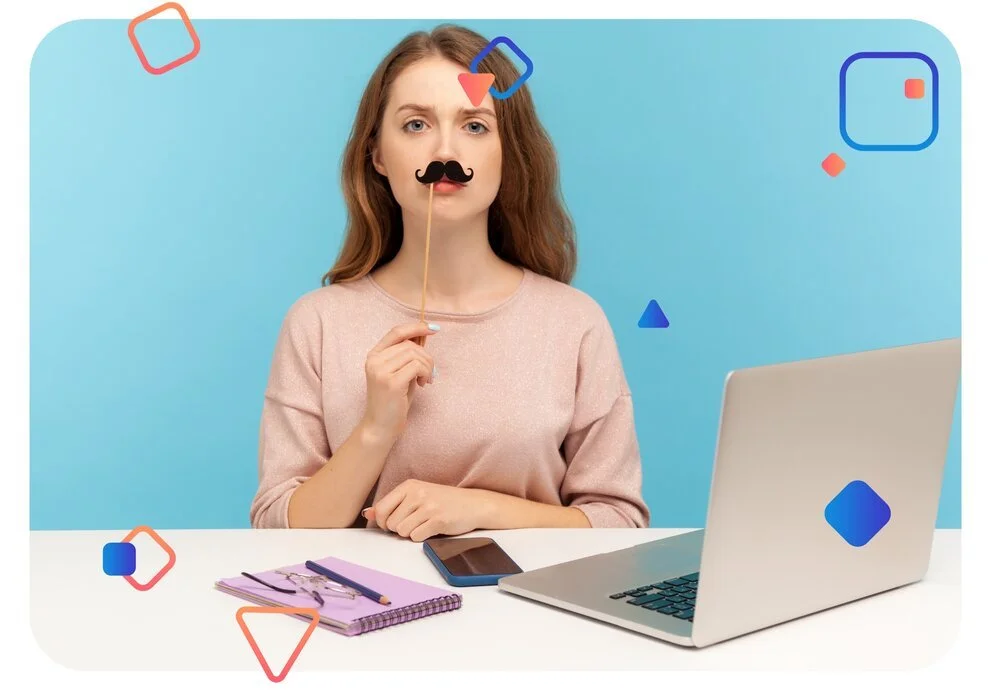Transition to eLearning courses in 6 steps
The aim of this guide is to support you in the project of digitising traditional educational content in e-learning courses.
This digital e-learning courses transformation involves a workflow in several stages: storyboard, scripting, design, activities, animation. The selection of your e-learning platform is also crucial.
If your company has always been focused on face-to-face training, switching to eLearning might appear to be a cumbersome task. This, however, couldn't be further from the truth! If you work with a good eLearning agency capable of managing the process for you, it'll be smooth sailing. They will be aware of all the intricacies of transitioning, making the shift to eLearning hassle-free for everyone involved. But before we get into the actual process of transitioning to eLearning, let’s talk about why it is a good thing for your organisation to opt for eLearning in the first place.
eLearning takes the difficulty out of learning, and is both flexible & future-oriented. It allows the employees to move at their own pace, and take their time when approaching something new. This is in stark contrast to a traditional learning culture, where a single employee out of sync might cause problems for the entire cohort. Imagine a session being held up by the many questions of the one, for example.
In addition, this flexibility promises a certain level of liberty that will make your employees more enthusiastic about online training than they were about in-person training. There's no expectation for them to all be at the session planned at exactly 3pm on exactly that one specific Tuesday in June when the speaker said they could deliver the training at your offices - instead, your team members can choose to use the naturally slower business days we all sometimes experience, and spend their otherwise idle time on something very purposeful.
TheLearning LAB eLearning agency.
So, how do you undertake this transition?
Whether you’re a baby boomer, millennial, or Gen Z, you can’t deny the fact that the world is more tech-centric today than ever before. As a result, a tech-savvy employee is worth much more to a company than an only mildly tech-literate individual.
eLearning forces your employees to develop the necessary technological skills, too, giving it yet another edge over traditional learning. Think of it as hitting two birds with one stone! We’ve summarised this traditional-to-technological learning shift in just six simple and easy to remember steps. By following this basic backbone, you can't go wrong.
The steps for a great shift towards eLearning
Step 1: Analyse the situation
Analyse your employees' needs, the Learner population demographics, and their current understanding of the subject at hand. If you're a company that already has a well-established face-to-face learning course, you could use the existing certification levels to get an idea of where everyone stands.
If not, you may wish to bring an eLearning agency, like TheLearning LAB, on board. We will carry out a detailed assessment of needs and identify which learning goals are most suitable for your organisation.
One of the questions we get most often is: can a traditional learning curriculum be reshaped to be made virtual? The answer is yes, and no. You can use the premade lectures and aims, but only as a reference point - as what eLearning is about is far more engaging than words on a page!
An eLearning environment is very different from a traditional class or seminar environment. There are certain techniques used by eLearning agencies to keep the employees interested and retention rates high.
For example, our eLearning programs are a mix of video, infographic, and gamification content, which makes learning memorable and engaging. More often than not, you will have to craft a curriculum from scratch, using your previous teachings only as a guiding light rather than a full roadmap.
e-learning agency, course design scorm
Step 2: Identify the course format
There are several online learning course formats, some of them more suited for use in the corporate world than others. Many unique factors go into choosing the right format, from the topic to learning goals, timings and certification options. We, therefore, suggest bringing this up with the eLearning agency you hire. They can help you best, as every case is different.
Two examples of course format models are the synchronous and asynchronous learning techniques.
Synchronous learning refers to a live class in which employees can voice their concerns using the comment box or direct their queries in real-time. Whereas, Asynchronous learning is a pre-recorded lecture or video that the audience can listen to at their own pace.
TheLearning LAB Geneva
Step 3: Set up the framework & outline
The framework is the foundation stone of any educational course, and the importance of being careful with your choice of framework is amplified for eLearning due to its remote use and indepent learning base. The term framework here refers to the medium which you will be dispatching your lectures - the all-important Learning Management System.
There are myriad choices, including our own video-first platform known as LMS LAB. Apart from this, you can also ask for a custom made solution on well-known platform such as Moodle. Any good eLearning agency will offer you the choice, and help you understand which is best for your specific needs. Then you'll outline your goals and aims, as per your audience and the scope of your digital training endeavours.
Step 4: Evaluate
After you’ve set up the framework and you’ve got the course outline, it may seem as though everything is ready to go - but now comes another, equally viral, step. You must go back and evaluate everything from the ground up to the top and then back to the bottom. This will help you identify potential problems and solve them while the curriculum is still in the development phase.
We suggest not skipping this step even if you're in a race against time because it will most probably save your precious time and money down the line.
A nifty rule of thumb is comparing your finished course structure with the goals you set in Step 1 and holding them side by side. Compare and contrast. Does your course do justice to the ideals you set yourself?
If it doesn't, address those issues right away, even if it requires completely discarding a particular module of your eLearning program or restructing a significant aspect of your outline - the end result will be worth it.
Step 5: Test run
A team of beta testers is a crucial part of the process before you go ahead and release eLearning to your entire team or organisation. This will unveil any bugs or glitches that may be hiding.
Consider this test run a true experiment. Try to add as much diversity as you can into the team of beta testers. Add some new employees as well as expert veterans of your organisation, some tech-literate and some less tech-savvy individuals. This will help you identify issues across the whole spectrum of possible concerns, ensuring you are left with no issues in your eLearning course.
eLearning Content Lab Geneva
Step 6: Dispatch & launch
If you are a large organisation and are planning a company-wide roll out for this new development programme, then creating the credentials for everyone will also require some time.
A quick way forward would be asking your in-house IT to automate the entire process, or, if your eLearning program is being developed by an agency, you may wish to ask them to create the credentials. Be sure to provide them with the employee's names, email address, and other relevant information.
And finally, eLearning success is yours!
You see, it isn’t as difficult as you may have earlier fretted it would be to shift from traditional to eLearning. According to Business Wire, investment in eLearning is projected to increase to $350 Billion by the end of 2025, so don't let misconceptions hold you back! eLearning will bring your organisation an increase in employee productivity, higher retention rates, and, ultimately a steady rise in corporate profits.
If you want the transition to be as quick as possible without compromising on the quality, consider hiring an experienced eLearning agency - such as our Geneva-based agency TheLearning LAB!
We have served clients from all around the world, and our extensive experience and eye for detail allows us to implement eLearning solutions both effectively and smoothly.




